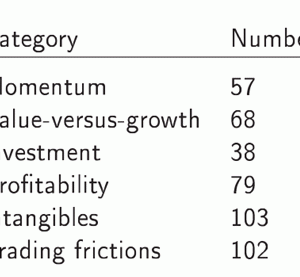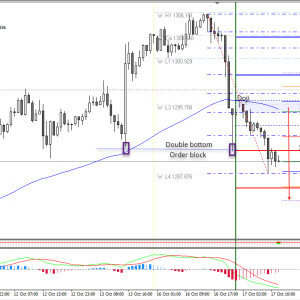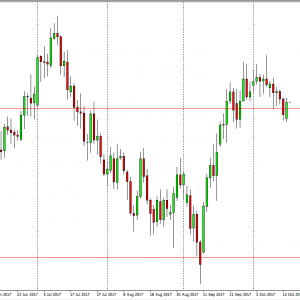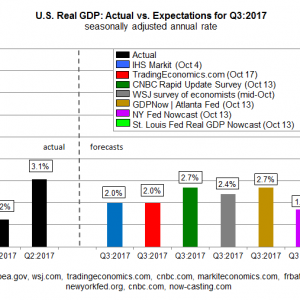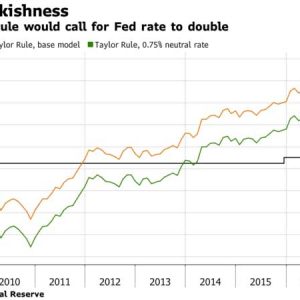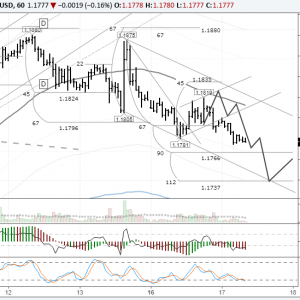Latest Posts
-
Finance 0
Morgan Stanley Q3 2017 Earnings Beat Boosts Shares
Morgan Stanley (MS) Q3 2017 earnings were released before opening bell this morning. The firm reported earnings of 93 cents per share on $9.2 billion in revenue, compared to the consensus estimates of 81 cents per share on $9 billion in revenue. In the year-ago quarter, the firm reported earnings of 81 cents per share on $8.9 billion in revenue. “Our third quarter results reflected the stability our Wealth Management, Investment Banking and Investment Management businesses bring when our Sales and Trading business faces a subdued environment,” CEO James Gorman said in a statement with the Morgan Stanley Q3 2017 earnings release. “Our ba...On October 17, 2017 / By Kurt Osterberg -
Finance 0
Morning Call For Tuesday, Oct. 17
OVERNIGHT MARKETS AND NEWS Dec E-mini S&Ps (ESZ17 -0.02%) this morning are little changed, down -0.03%, and European stocks are up +0.08%. U.S. stock indexes were consolidating their gains from Monday’s rally to new all-time highs. The upside in European stocks was limited after Spain cut its 2018 GDP estimate to 2.3% from 2.6%, citing the impact of the political standoff in Catalonia. Also, the German Oct ZEW survey expectations of economic growth rose less than expected. Asian stocks settled mostly higher: Japan +0.38%, Hong Kong +0.02%, China -0.19%, Taiwan -0.47%, Australia +0.73%, Singapore +0.18%, South Korea +0.21%, India -0....On October 17, 2017 / By Kurt Osterberg -
Finance 0
Gold Prices Tumble As Fed Rate Hike Speculation Heats Up Anew
Gold prices turned lower as Fed rate hike expectations began to swell anew after a pause last week. The priced-in probability of another increase before the calendar turns to 2018 rose to 80.2 percent, the highest in nearly two years. The US Dollar dutifully rose alongside front-end Treasury bond yields, undermining the appeal of non-interest-bearing and anti-fiat assets exemplified by the yellow metal. A clear-cut catalyst is not obvious from here, at least in the near term. The economic calendar is relatively tame, the Fed-speak schedule is uneventful and US stock index futures are trading flat ahead of the opening bell on Wall Street, ...On October 17, 2017 / By Kurt Osterberg -
Finance 0
Retesting Investment Anomalies
Audio Length: Last week’s podcast was in a new special-edition format, jointly hosted with Wesley Gray, CEO of Alpha Architect. Gray is a Philadelphia-area PhD and investment manager. He plans to join me in our Wharton School studio to help profile academic work that is most relevant to investors. Introducing this week’s guest, Dr. Lu Zhang of Ohio State University, Gray described him as one of the world’s premiere experts on asset pricing who is examining the “factor wars” that are raging in academic circles. Zhang and his team spent three years assembling SAS code to test 447 different investment anomalies—that is, investm...On October 17, 2017 / By Kurt Osterberg -
Finance 0
Gold Double Bottom Support Is Broke
The gold enjoyed a steady uptrend during Monday but a small doji (stop candle) that appeared at W L3 resistance suggested a possible momentum change. Straight after the doji has been formed the price continued to fall and it finally broke the double bottom and D L3 pivot. Traders should pay attention to possible short-term rejections around D L3 -1290.52 while a stronger retracement to the upside might target the POC zone 1294.80-1296.20 ( W L3, historical sellers, Daily camarilla pivot, EMA89, ATR pivot). Rejection from the POC zone targets 1292.20, 1290.52. If the price proceeds further down watch for 1287.87, 1286.25 and the final ATR proj...On October 17, 2017 / By Kurt Osterberg -
Finance 0
USD/JPY And AUD/USD Forecast – Tuesday, Oct. 17
USD/JPY The US dollar fell against the Japanese yen initially at the open on Monday but then found enough footing to break above the 112 level. I believe that the market is trying to consolidate around this area so that we can continue to the upside, especially with the interest rates rising in the United States. I think that we will continue to see a significant amount of noise in this area, but given enough time we should go looking towards the 114.50 level above which is the top of the longer-term consolidation. It will do a breakdown from here, I suspect that the 111-handle underneath will offer plenty of support, so either way am not in...On October 17, 2017 / By Kurt Osterberg -
Finance 0
Temporary Speed Bump Expected To Weigh On US Q3 GDP Report
GDP growth in the third quarter is widely expected to decelerate in the government’s “advance” estimate that’s due at the end of this month. Part of the projected slowdown is due to the temporary effects of hurricanes, according to analysts. Forecasters are looking for a 2.4% increase in output for Q3, based on the average estimate for several models and economic surveys compiled by The Capital Spectator. The projection is well below Q2’s strong 3.1% increase. The weaker trend looks worrisome, but economists anticipate that growth will bounce back as the weather-related headwind fades. “While the effects of the hurricanes on the U...On October 17, 2017 / By Kurt Osterberg -
Finance 0
Global Stocks Just Shy Of Record Highs As Dollar, Yields Rise On Taylor Tension
Global markets traded near all-time highs on Tuesday, with S&P futures, Asian shares and European stocks all flat this morning, while oil continued to gain on Kurdish geopolitical concerns while most industrial metals fell. The euro extended its recent slide and stocks drifted as Spain’s escalating hard-line response to the Catalonian secession threat fueled concern the crisis may intensify. Markets initially followed the US reaction to reports of a positive John Taylor (Rule) – Donald Trump meeting, which sent 2Y Treasury yields to their highest since 2008 and pushed up the dollar higher amid speculation the next Federal Reserve ...On October 17, 2017 / By Kurt Osterberg -
Finance 0
EURUSD: Price Approaching The Neckline
On Monday the 16th of October, trading on the euro/dollar pair closed slightly down. The pair spent most of its time in a sideways trend. After dropping to 1.1781, the euro recovered its lost ground to reach 1.1819. Still, the price didn’t make it to the balance line, which at that point ran through 1.1826 levels. The price also missed the 45th degree as a result of pressure on the euro. This pressure is due to the situation regarding Catalonian independence. According to the Spanish government, Carles Puigdemont, the president of Catalonia, has yet to clarify whether or not he actually made an official declaration of independence from Sp...On October 17, 2017 / By Kurt Osterberg -
Finance 0
Technically Speaking: Clarifying Overbought, Extended & Bullish
The market is downright bullish. There is little reason to argue the point given the bullish trends of markets globally which are strongly trending, positively correlated, and simultaneously breaking out to all-time highs. Of course, such is not surprising given the massive levels of Central Bank interventions, suppressed interest rates, and global coordination between Government’s and major asset managers (banks) over the last eight years. Importantly, as bullishness has reached historically high levels, the fear of a market crash, or another crisis, has faded into the abyss. As Mark DeCambre noted: “By at least one measure, the S&...On October 17, 2017 / By Kurt Osterberg
Top Posts
-
 The Importance for Individuals to Use Sustainable Chemicals
The Importance for Individuals to Use Sustainable Chemicals
-
 Small Businesses: Finding the Right Candidate for the Job
Small Businesses: Finding the Right Candidate for the Job
-
 How to Write the Perfect Thank You Letter After Your Job Interview
How to Write the Perfect Thank You Letter After Your Job Interview
-
 3 Best Large-Cap Blend Mutual Funds For Enticing Returns
3 Best Large-Cap Blend Mutual Funds For Enticing Returns
-
 China suspected in massive breach of federal personnel data
China suspected in massive breach of federal personnel data







